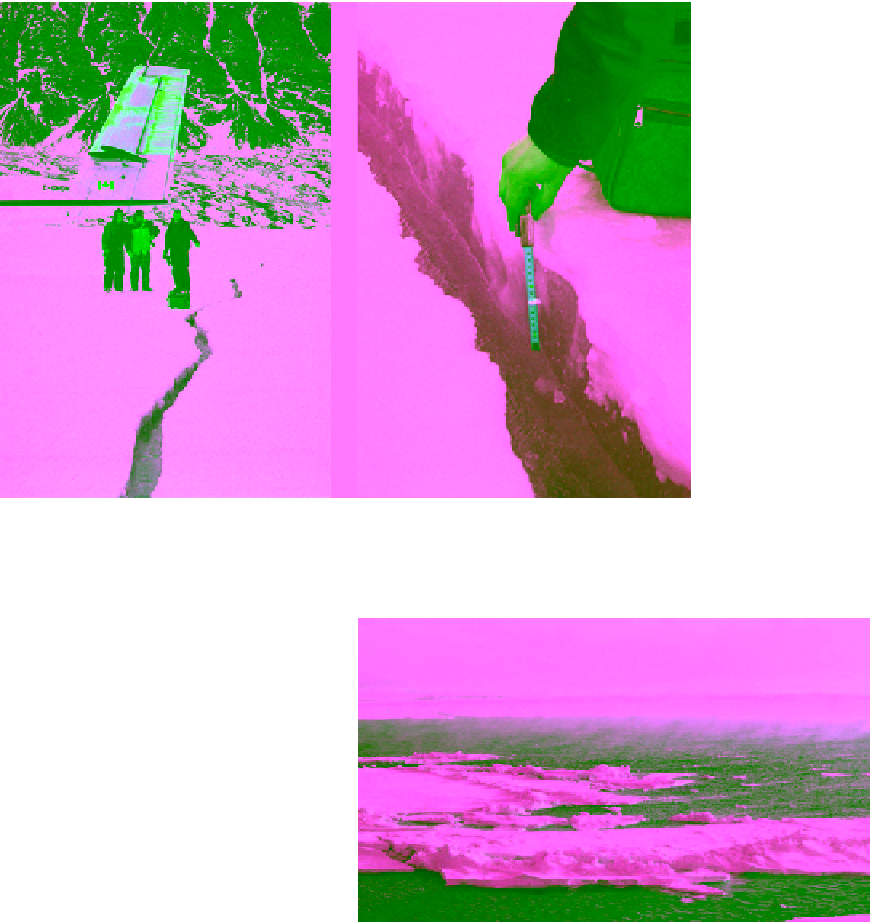Geology Reference
In-Depth Information
Figure 2.54
Crack in fast FY ice in Frederick Hyde Fjord, Greenland, and tail section of a Twin Otter aircraft, used
for surveying, 25 May 1994 (left); details of the refrozen crack depth of 200 mm (right) indicates freeboard of ice
sheet (photo by N. K. Sinha).
the air. The team had to haul snow from the side of the
mountains to spread on the ice in order to increase the
albedo of the selected 3km long runway strip, and there-
fore keep the ice cooler and increase the traction [
Sinha
,
1995]. This process took several days.
Leads are fractures that are wide enough to act as
a navigable passageway for surface vessels. They are the
most common form of large‐scale deformations caused
by ice divergence. Leads are usually observed within pack
ice or between pack ice and land. They can often branch
or intersect, creating a complex pattern of linear features.
If leads are formed between floating pack ice and fast ice,
they are called flaw leads. These are commonly observed
in the Eurasian Arctic region.
Pärn and Haapala
[2011]
studied their frequency of occurrence in the Gulf of Finland
during the period 1971-2007. If a lead exists between the
shore and the pack ice, it is called a coastal lead. In addition
to providing navigational routes to marine vehicles, they
have a pronounce effect on the heat exchange between
ocean and atmosphere. While the ice sheet acts as an insula-
tor between ocean and atmosphere, leads enhance the heat
flow to the much colder atmosphere in winter in the polar
regions. As a result, although leads typically represent
only a few or at most several percent of the ice pack area,
they may account for 50% of total heat flux from the
ocean to the atmosphere [
Ruffieux et al
., 1995]. Leads may
contain brash ice and/or covered with Nilas and/or YI.
Open leads have a low albedo relative to the surround-
ing ice. However, in the Arctic winter, the enormous tem-
perature difference between the atmosphere (typically less
than −30 °C) and the ocean (at freezing temperature of
Figure 2.55
A lead in Fram Strait showing frost smoke gener-
ated from evaporation at the surface and condensation above
the surface (photo taken by D. Sudom of the NRC of Canada).
−1.8 °C) causes the lead to freeze rapidly. The temperature
gradient between newly opened lead and the atmosphere
can be so high that the lead “steams” with frost smoke.
This is fog‐like clouds formed by the contact of colder air
with relatively warm water when evaporated water con-
densates immediately above the surface. It comprises
small crystals of ice and may persist while ice cover is
forming (Figure 2.55). This turbulent heat and mass
transfer from leads to the atmosphere during winter
affects atmospheric processes hundreds of meters above
and hundreds of kilometers downstream from leads.
Hence, in addition to their importance for marine naviga-
tion leads are also important for their impact on weather
and climate systems [
Eisen and Kottmeier
, 2000].

